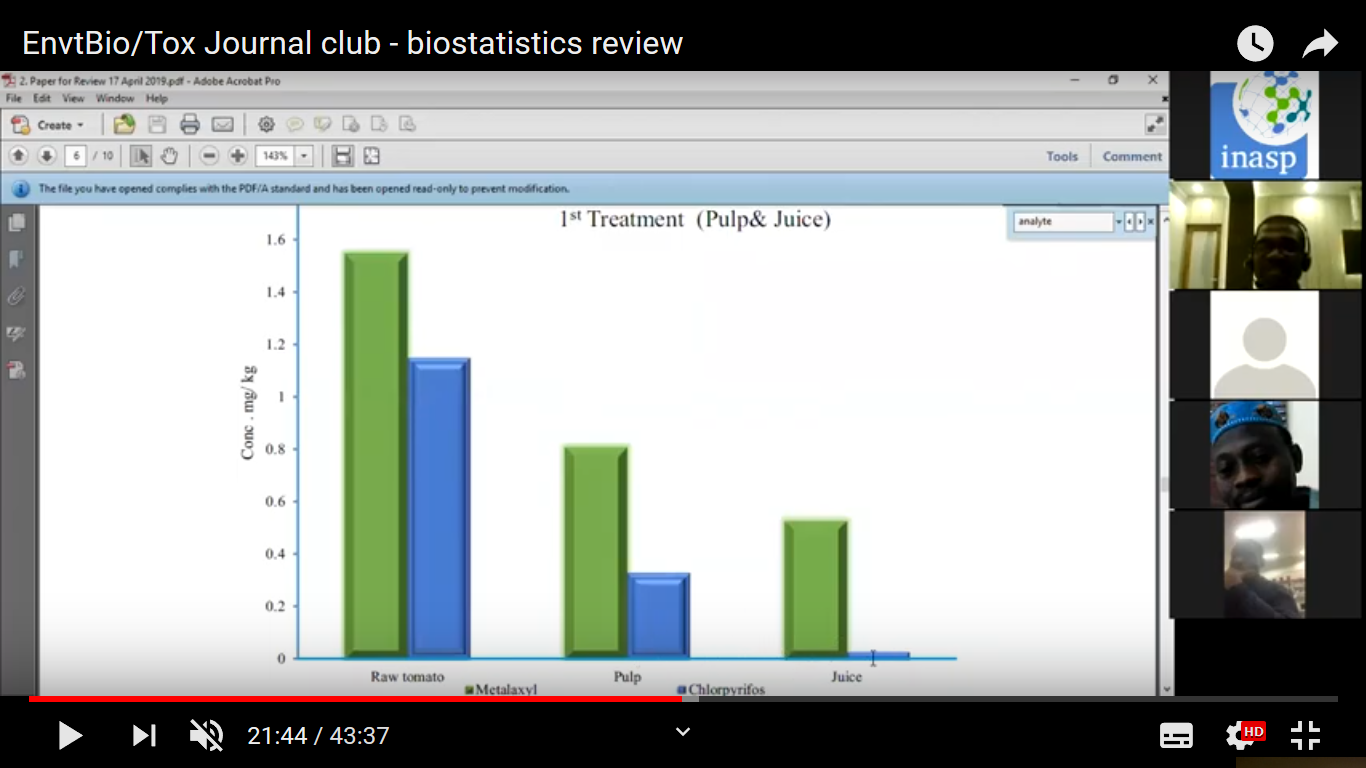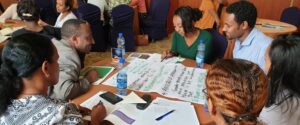
Online journal clubs spark active discussions and new ways of exploring literature
Andy Nobes reflects on the online journal clubs that started this year and build on the potential of social learning and peer collaboration that we have already seen with AuthorAID.
The AuthorAID project aims to build the confidence, knowledge and skills needed by Southern researchers and organizations so that their research can be published and communicated. Through our online courses, we have already seen the impact and potential of social learning and peer collaboration and mentoring. Earlier this year, we began trialling a new strand to this work: online journal clubs.
The idea of these journal clubs was to bring together the key elements of face-to-face journal clubs – reading, critical analysing and discussing the latest journal papers; and also learning about the structure and process of writing and communicating research – but in a purely online environment. Such initiatives have been tried before in small thematic groupings, but rarely at scale, and we wanted to try this as a way of engaging geographically diverse members of the AuthorAID community to learn together.
We launched with four online journal clubs, in four broad themes, each with a guest coordinator drawn from our AuthorAID network (our facilitators are based in Kenya, Nigeria and Mexico, with an additional statistician and data expert from Nigeria providing support across all the groups). The first topics were: Biomedicine & Health; Environmental Biology and Toxicology; Social Sciences in Health and Development; and Education & Science Communication. I then added a fifth journal in the area of library and information science and bibliometrics, which I facilitate myself and which is helping me gain a deeper understanding of the dynamics and challenges of this approach.
The idea has proved popular, with over 800 people signed up across all the journal clubs, largely from Africa. In three cases, due to the choice of technology platform, the journal clubs are at full capacity.
But the successes go beyond numbers. The initial engagement in the groups has remained energetic, with lots of initiative in tackling the activities. In addition to the official facilitators, we have seen other members of the groups step into informal co-facilitator roles assisting with video discussions to contribute to the learning. This has largely happened organically without INASP’s intervention.
“The journal club for me is an exciting space to interact with scholars from various places and skills. Given the number of people who joined the clubs it shows people want to learn, they want to grow their skills and knowledge in research. It also shows the needs for research mentorship spaces for emerging scholars that is longer term, has quick feedback mechanism for the researchers who raise queries.”
Aurelia Munene, journal club facilitator
As we celebrate the successes so far and look ahead to formally assessing the long-term impact, it seems a good time to take stock of some key things that we have been learning from the clubs so far:
- Some technology platforms work better than others for online journal clubs
The initial four journal clubs took different approaches to their underlying technology. Two of the clubs started on WhatsApp (with one also using LinkedIn for formal feedback), one started on Facebook, and one began on AuthorAID’s discussion forum. Most of the groups also used video discussion as a way of supplementing the text-based discussion, which featured the group members presenting their thoughts on the paper in live sessions. The facilitators also managed to persuade at least three authors to come and present their papers to the groups, and take questions from group members. These sessions were conducted on Zoom, and recorded and uploaded to YouTube so those who could not join the live session could watch later.
WhatsApp has a limit of 250 members in a group, which meant that the groups filled up quickly. The group on Facebook initially attracted a very large number of participants but engagement was low until that group also moved to WhatsApp.
The fourth group struggled to get group engagement on AuthorAID’s discussion forum, as we did not really design the forums for the kind of rapid, synchronous, informal discussion that our network was familiar with. Many researchers in Africa and Asia already communicate in groups using mobile apps like WhatsApp, Telegram, Viber and WeChat, and are much more likely to be comfortable and familiar with communicating in this way than ‘traditional’ internet forums and email listservs. We have now tried to ‘reboot’ this group using alternative platforms such as Slack. When I set up the fifth journal club, I also opted for WhatsApp, which led to immediate engagement and discussion.
Some participants have suggested alternatives platforms for the future such as the Telegram app, which has no upper limit on users. However, this is less well known and requires downloading a new app; so this might prove a barrier to use for some people.
- Groups include both active participants and ‘lurkers’
As any face-to-face journal club or book group finds, some group members participate more than others – some read the material and complete activities, while others do not. With online journal clubs, we find that the proportion of members who regularly engage is relatively small, and the proportion who complete the reading activities and comment is smaller. It’s quite possible that many group members are ‘lurkers’, reading and learning from the discussions but not contributing their thoughts – but it is difficult to differentiate between these members and those who don’t follow the discussions at all.
“Some are still trying to learn how to make contributions to this sort of platform. They are conscious it’s an academic environment and … they still don’t see themselves as academics even when they have joined. More like “We are still testing the waters.” This is why we should keep on doing what we are doing until they finally build confidence by seeing others do it.”
Felix Emeka Anyiam – Journal club facilitator and statistician
The groups tried were designed to be self-sustaining, community-led groups rather than relying on a single facilitator. However, peer feedback and open discussion did not happen immediately, and it took a while before some participants felt comfortable sharing and discussing their ideas
“It has been a learning experience for me these past few weeks and quite challenging too, as I have to respond to so many chats privately and on the group platform. Journal club is new to many of the members and some feel the coordinator has all the answers.”
Funmilayo Doherty – Journal club facilitator
As we know from our research writing MOOCs, there is often a trade-off between scale and active participation. The facilitators of the journal clubs have been very engaged within their groups and are looking to address the challenge of ensuring widespread engagement. However, this project is an attempt at scaling up an online version of what is usually a smaller, face-to-face discussion, so we need to bear in mind that these clubs are not ideal for everyone, and not necessarily a replacement for traditional journal or writing clubs. It is also conceivable that these clubs will organically split into smaller groups based on focused interests.
- With broad subject areas, paper choice can be a challenge
With the initial round of journal clubs, we deliberately chose not to start too many clubs at once and to keep the topics broad.
Choosing which paper to discuss is often chosen democratically – by voting on WhatsApp. However, because the groups are thematically broad, for example ‘biomedicine and health’, it has been difficult to keep everybody engaged and happy without splintering into different groups before we were ready to do so. Journal clubs traditionally focus not only on reading and discussing papers within a particular discipline, but also using this as a peer learning exercise about how to write and communicate our own work. It’s therefore important to keep this at the forefront of the participants mind.
We have discovered through the process that some topics are more popular than others. Papers that were quite general have been more popular than niche disciplinary topics, as are papers that were more about research tools or writing. For example, a paper focusing on an ethical consent tool, and a paper on ‘how to write a literature review’ had more engagement due to their broad appeal.
Another way to keep the whole group interested was by focusing on the data and statistical analysis of the papers in question – this is where our statistics expert was able to support all of the groups by explaining the statistical reporting and figures in a wide range of papers via video sessions.
- Keeping to the aims can be difficult – but learning is still going on when discussions drift
The nature and style of the groups has not always worked in achieving what we set out to do, which was a semi-structured discussion focused around analysing specific papers. However, regardless of whether people are concentrating on the task in hand and reviewing the paper that has been agreed, discussion is still ongoing about relevant topics, and the groups are developing into friendly communities of practice.
This initial phase of the journal clubs is intended as a pilot of the concept and will run until August. Over the coming weeks I’ll be speaking with the facilitators and looking at feedback from participants and synthesizing learning from the groups so that its impact can be assessed.
We hope that, after August, some additional groups will grow from this and cascade in more specific disciplinary areas, and we will be able to build on the learning from this first phase.
Thank you to our journal club facilitators: Dr. Zainab Yunusa-Kaltungo; Dr. Funmilayo Doherty; Aurelia Munene; Alejandra Arreola; Felix Emeka Anyiam

 Previous Post
Previous Post Next Post
Next Post


